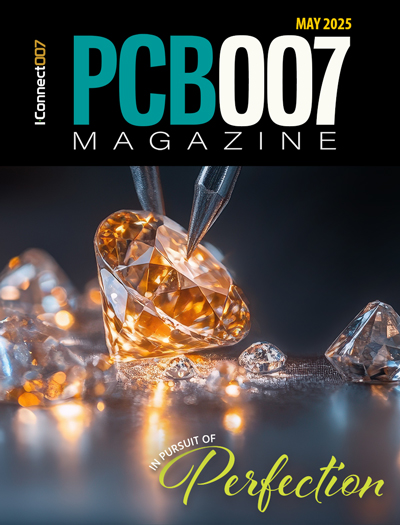-

-
News
News Highlights
- Books
Featured Books
- pcb007 Magazine
Latest Issues
Current Issue
Sales: From Pitch to PO
From the first cold call to finally receiving that first purchase order, the July PCB007 Magazine breaks down some critical parts of the sales stack. To up your sales game, read on!

The Hole Truth: Via Integrity in an HDI World
From the drilled hole to registration across multiple sequential lamination cycles, to the quality of your copper plating, via reliability in an HDI world is becoming an ever-greater challenge. This month we look at “The Hole Truth,” from creating the “perfect” via to how you can assure via quality and reliability, the first time, every time.

In Pursuit of Perfection: Defect Reduction
For bare PCB board fabrication, defect reduction is a critical aspect of a company's bottom line profitability. In this issue, we examine how imaging, etching, and plating processes can provide information and insight into reducing defects and increasing yields.
- Articles
- Columns
- Links
- Media kit
||| MENU - pcb007 Magazine
15 Years of Radio Data Reveals Evidence of Space-Time Murmur
June 30, 2023 | NASA JPLEstimated reading time: 1 minute
Scientists have found evidence of a universal background of gravitational waves, or ripples in the fabric of space-time.
The motion of black holes and other massive objects through space can create ripples in the fabric of the universe, called gravitational waves. On June 28 scientists announced the first evidence of a background of long-wavelength gravitational waves that fills the cosmos. These waves are thought to have been created over eons by supermassive black holes, up to billions of times the mass of our Sun, circling each other before they merge. Detecting the gravitational wave background is analogous to hearing the hum of a large group of people talking at a party, without distinguishing any particular voice.
The background ripples detected by NANOGrav could help scientists better understand how gravitational waves are created and what happens to them as they propagate through the universe. They could also be used to study supermassive black hole mergers, events that can last for millions of years. Scientists think these mergers happen in most galaxies and influence their evolution.
The North American Nanohertz Observatory for Gravitational Waves (NANOGrav) presented the evidence in a series of papers published in the Astrophysical Journal Letters. NANOGrav is a National Science Foundation-funded Physics Frontiers Center of more than 190 scientists from the United States and Canada, including scientists at NASA’s Jet Propulsion Laboratory in Southern California and other NASA centers. The collaboration has spent more than 15 years collecting high-precision data from ground-based radio telescopes, looking for these gravitational waves.
The discovery complements the first-ever detection of gravitational waves in 2015 by LIGO, the Laser Interferometer Gravitational Observatory. Those signals, at a much shorter wavelength than the new discovery, were from black holes about 30 times the mass of our Sun.
NASA is contributing to the ESA (European Space Agency)-led Laser Interferometer Space Antenna mission, a future space-based observatory that will detect gravitational waves that are in a wavelength range between those detected by NANOGrav and LIGO.
Testimonial
"Advertising in PCB007 Magazine has been a great way to showcase our bare board testers to the right audience. The I-Connect007 team makes the process smooth and professional. We’re proud to be featured in such a trusted publication."
Klaus Koziol - atgSuggested Items
OKI Launches Rigid-Flex PCBs with Embedded Copper Coins Featuring Improved Heat Dissipation for Space Equipment Applications
07/29/2025 | BUSINESS WIREOKI Circuit Technology, the OKI Group’s printed circuit board (PCB) business company, has developed rigid-flex PCBs with embedded copper coins that offer improved heat dissipation for use in rockets and satellite-mounted equipment operating in vacuum environments.
Airbus-built CO3D Constellation Successfully Launched to Map our Planet in 3D
07/28/2025 | AirbusThe four Airbus-built CO3D (Constellation Optique 3D) satellites have been successfully placed into orbit by an Arianespace Vega-C rocket from the European Spaceport in Kourou, French Guiana.
Ocean guardian Ready for Takeoff: Second Copernicus Sentinel-6 Satellite Heads to Launch Site
07/24/2025 | AirbusMonitoring of Earth’s rising oceans is about to get a powerful boost! Airbus, the prime contractor for the Copernicus Sentinel-6 missions, confirms that the second satellite in this critical series is on its way to the launch site in Vandenberg, California. Liftoff is slated for November 2025.
Mobix Labs Secures Surge of High-Value Defense Orders, Igniting Growth in its Filter Interconnect Products
07/23/2025 | BUSINESS WIREMobix Labs, Inc., a leading innovator of advanced connectivity and electromagnetic interference (EMI) filtering technology, announced significant quarter-over-quarter revenue growth in its filter and interconnect products, powered by strong customer demand and major wins across mission-critical defense and aerospace programs.
Linde Announces Major U.S. Investments to Support Commercial Space Sector
07/23/2025 | BUSINESS WIRELinde announced ambitious new investments to fuel the next frontier of space exploration. With two new long-term agreements to supply bulk industrial gases for rocket launches, Linde is strengthening its leadership in the rapidly expanding U.S. space industry.


